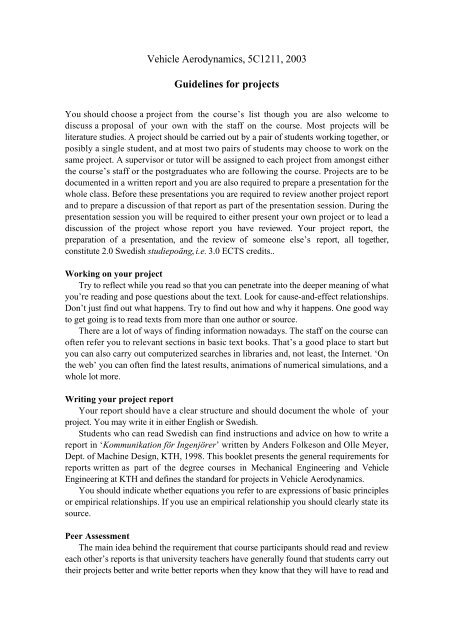Vehicle Aerodynamics, 5C1211, 2003 Guidelines ... - KTH Mechanics
Vehicle Aerodynamics, 5C1211, 2003 Guidelines ... - KTH Mechanics
Vehicle Aerodynamics, 5C1211, 2003 Guidelines ... - KTH Mechanics
Create successful ePaper yourself
Turn your PDF publications into a flip-book with our unique Google optimized e-Paper software.
<strong>Vehicle</strong> <strong>Aerodynamics</strong>, <strong>5C1211</strong>, <strong>2003</strong><strong>Guidelines</strong> for projectsYou should choose a project from the course’s list though you are also welcome todiscuss a proposal of your own with the staff on the course. Most projects will beliterature studies. A project should be carried out by a pair of students working together, orposibly a single student, and at most two pairs of students may choose to work on thesame project. A supervisor or tutor will be assigned to each project from amongst eitherthe course’s staff or the postgraduates who are following the course. Projects are to bedocumented in a written report and you are also required to prepare a presentation for thewhole class. Before these presentations you are required to review another project reportand to prepare a discussion of that report as part of the presentation session. During thepresentation session you will be required to either present your own project or to lead adiscussion of the project whose report you have reviewed. Your project report, thepreparation of a presentation, and the review of someone else’s report, all together,constitute 2.0 Swedish studiepoäng, i.e. 3.0 ECTS credits..Working on your projectTry to reflect while you read so that you can penetrate into the deeper meaning of whatyou’re reading and pose questions about the text. Look for cause-and-effect relationships.Don’t just find out what happens. Try to find out how and why it happens. One good wayto get going is to read texts from more than one author or source.There are a lot of ways of finding information nowadays. The staff on the course canoften refer you to relevant sections in basic text books. That’s a good place to start butyou can also carry out computerized searches in libraries and, not least, the Internet. ‘Onthe web’ you can often find the latest results, animations of numerical simulations, and awhole lot more.Writing your project reportYour report should have a clear structure and should document the whole of yourproject. You may write it in either English or Swedish.Students who can read Swedish can find instructions and advice on how to write areport in ‘Kommunikation för Ingenjörer’ written by Anders Folkeson and Olle Meyer,Dept. of Machine Design, <strong>KTH</strong>, 1998. This booklet presents the general requirements forreports written as part of the degree courses in Mechanical Engineering and <strong>Vehicle</strong>Engineering at <strong>KTH</strong> and defines the standard for projects in <strong>Vehicle</strong> <strong>Aerodynamics</strong>.You should indicate whether equations you refer to are expressions of basic principlesor empirical relationships. If you use an empirical relationship you should clearly state itssource.Peer AssessmentThe main idea behind the requirement that course participants should read and revieweach other’s reports is that university teachers have generally found that students carry outtheir projects better and write better reports when they know that they will have to read and
eview someone else’s report later on. The staff on this course expect you to be moreaware of the criteria and goals for the quality of the project work when you know thatyou’re going to be reading each other’s reports.Reviewing someone else’s reportApply the same criteria when you review someone else’s report as you used when youwrote your own report — see above. Try to write a review that confirms for the otherstudents that they have carried out a good project and at the same time supports andencourages improvements that involve a reasonable amount of effort. It is far too easywithin the academic culture, i.e. the world of research, to have an idea of what theabsolutely perfect project report would be like and then write a list of all the failings anderrors in the report that you have reviewed. Such an assessment has very little value in alearning context. A worthwhile guideline is to aim at expressing two positive assessmentsfor every negative criticism you make.A few concise objectivesAn objective for the project:• it should explain ‘how and why’ and not just describe.Objectives for the project report:• it should present the whole project• it should be written in your owm words• it should be clearly written and even pleasant to read• it should have a proper structureObjectives for the review:• it should be based on the objectives above• it should emphasize the good points• it should support a reasonable improvementTimetableYou should hand in your project report by Monday the 12th May <strong>2003</strong> at the latest.You should fetch a report to review on Wednesday the 14th May and you shuld carry outthe review before the first session of presentations on Wednesday the 21st May, 10-12a.m. A second session (2h) will take place during the same week.Tony Burden, 8th April <strong>2003</strong>
















